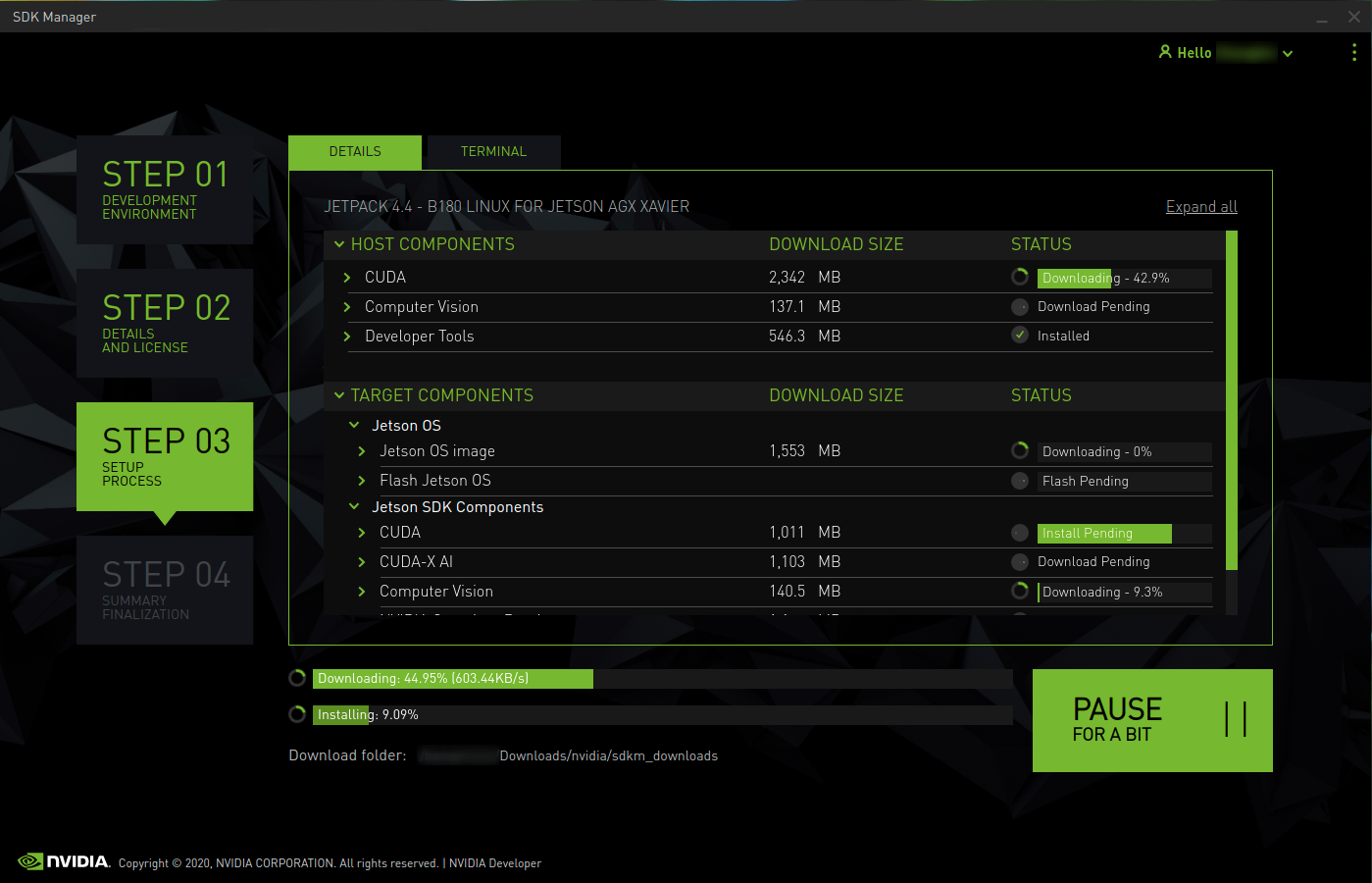Hardware
NVIDIA Jetson
What is NVIDIA Jetson series?
The NVIDIA Jetson series is a range of embedded computing boards that are designed for edge computing applications. They are powered by NVIDIA GPUs and are capable of running deep learning models and AI algorithms at the edge. The Jetson series includes the Jetson Nano, Jetson Xavier NX, and Jetson AGX Xavier.
Serial
To observe the U-boot console, you need to connect a TTL to USB cable. The connection method is as shown in the following:
Jetson (UART RXD) -> TXD
Jetson (UART TXD) -> RXD
Jetson (GND) -> GND
The baud rate is 115200.
Flash Jetson Nano
Download SDK Manager here

Boot from SD Card
Set the Jetson Nano enter recovery mode then connect it to the host PC. Flash an Jetson OS, do not check the SDK option.
This should be done on a Ubuntu Host PC:
- Install
dtctool:
> sudo apt-get install device-tree-compiler
- Decompile the dts file (use your path according to the Jetpack 4.x)
> cd ~/nvidia/nvidia_sdk/JetPack_4.6.5_Linux_JETSON_NANO_TARGETS/Linux_for_Tegra/kernel/dtb/
> dtc -I dtb -O dts -o tegra210-p3448-0002-p3449-0000-b00.dts tegra210-p3448-0002-p3449-0000-b00.dtb
- Modify the
tegra210-p3448-0002-p3449-0000-b00.dtsfile, you should modify the codes as below which are marked in red.
sdhci@700b0400 {
compatible = "nvidia,tegra210-sdhci";
reg = <0x0 0x700b0400 0x0 0x200>;
interrupts = <0x0 0x13 0x4>;
aux-device-name = "sdhci-tegra.2";
iommus = <0x30 0x1b>;
nvidia,runtime-pm-type = <0x0>;
clocks = <0x26 0x45 0x26 0xf3 0x26 0x136 0x26 0xc1>;
clock-names = "sdmmc", "pll_p", "pll_c4_out2", "sdmmc_legacy_tm";
resets = <0x26 0x45>;
reset-names = "sdhci";
status = "okay"; #change this to okay
tap-delay = <0x3>;
trim-delay = <0x3>;
mmc-ocr-mask = <0x3>;
max-clk-limit = <0xc28cb00>;
ddr-clk-limit = <0x2dc6c00>;
bus-width = <0x4>;
calib-3v3-offsets = <0x7d>;
calib-1v8-offsets = <0x7b7b>;
compad-vref-3v3 = <0x7>;
compad-vref-1v8 = <0x7>;
pll_source = "pll_p", "pll_c4_out2";
ignore-pm-notify;
cap-mmc-highspeed;
cap-sd-highspeed;
nvidia,en-io-trim-volt;
nvidia,en-periodic-calib;
cd-inverted;
wp-inverted;
pwrdet-support;
nvidia,min-tap-delay = <0x6a>;
nvidia,max-tap-delay = <0xb9>;
pinctrl-names = "sdmmc_schmitt_enable", "sdmmc_schmitt_disable", "sdmmc_clk_schmitt_enable", "sdmmc_clk_schmitt_disable", "sdmmc_drv_code", "sdmmc_default_drv_code", "sdmmc_e_33v_enable", "sdmmc_e_33v_disable";
pinctrl-0 = <0x8c>;
pinctrl-1 = <0x8d>;
pinctrl-2 = <0x8e>;
pinctrl-3 = <0x8f>;
pinctrl-4 = <0x90>;
pinctrl-5 = <0x91>;
pinctrl-6 = <0x92>;
pinctrl-7 = <0x93>;
vqmmc-supply = <0x3b>;
vmmc-supply = <0x4c>;
# Add these lines
cd-gpios = <0x5b 0xc2 0x0>;
sd-uhs-sdr104;
sd-uhs-sdr50;
sd-uhs-sdr25;
sd-uhs-sdr12;
# end of added lines
mmc-ddr-1_8v;
# Add these two lines
no-mmc;
uhs-mask = <0xc>;
# end of added lines
linux,phandle = <0xba>;
phandle = <0xba>;
- Compile the dtb file
> dtc -I dts -O dtb -o tegra210-p3448-0002-p3449-0000-b00.dtb tegra210-p3448-0002-p3449-0000-b00.dts
- Flash the OS to Jetson Nano emmc again with the following command:
> cd ~/nvidia/nvidia_sdk/JetPack_4.6.5_Linux_JETSON_NANO_TARGETS/Linux_for_Tegra/
> sudo ./flash.sh jetson-nano-emmc mmcblk0p1
The flash.sh will flash the os to emmc again.
- When the flash finished, Jetson Nano will reboot shortly. Serial to the Jetson Nano and finish the basic Ubuntu configuration:
> sudo screen /dev/ttyACM0 115200
The following steps should be done on Jetson Nano.
- After second reboot, ssh to Jetson Nano via network. Check the SD card device:
> ls /dev/mmc*
You will see a new device like mmcblk1
- Create partition and format mmcblk1:
> sudo fdisk /dev/mmcblk1
In the fdisk interface:
- Press p to print the current partition table (optional but useful to see existing partitions).
- Press n to create a new partition.
- Choose p for a primary partition.
- Specify the partition number (1 for the first partition if it’s empty).
- Choose the starting and ending sectors, or press Enter to use the default values, which will use all available space.
Write the partition table:
- Press w to write the changes and exit fdisk.
- Format mmcblk1p1
> sudo mkfs.ext4 /dev/mmcblk1p1
- Mount the SD Card:
> sudo mkdir /mnt/sdcard
> sudo mount /dev/mmcblk1p1 /mnt/sdcard
You first need to flash the eMMC normally with SDK manager. This process will install bootloader and firmware to the module.
- Copy Root Filesystem to SD Card
> sudo rsync -axHAWX --numeric-ids --info=progress2 --exclude=/proc / /mnt/sdcard
- Edit fstab file from the SD card to make it mount automatically after reboot:
> sudo nano /mnt/sdcard/etc/fstab
For example:
/dev/mmcblk1p1 / ext4 defaults 0 1
- Modify Boot Sequence
What you need to do is to add a new boot entry, change root to the desired device (e.g. "/dev/mmcblk1p1") and update the default entry to be "microsd". The following is an example of the boot configuration file:
> sudo nano /boot/extlinux/extlinux.conf
For example:
TIMEOUT 30
DEFAULT microsd
MENU TITLE L4T boot options
LABEL microsd
MENU LABEL microsd kernel
LINUX /boot/Image
INITRD /boot/initrd
APPEND ${cbootargs} quiet root=/dev/mmcblk1p1 rw rootwait rootfstype=ext4 console=ttyS0,115200n8 console=tty0 OS=l4t fbcon=map:0 net.ifnames=0
LABEL primary
MENU LABEL primary kernel
LINUX /boot/Image
INITRD /boot/initrd
APPEND ${cbootargs} quiet root=/dev/mmcblk0p1 rw rootwait rootfstype=ext4 console=ttyS0,115200n8 console=tty0 OS=l4t fbcon=map:0 net.ifnames=0
# When testing a custom kernel, it is recommended that you create a backup of
# ...
# ...
- Now reboot and verify your rootfilesystem is on the SD card.
> df -h
- Use emmc as a data storage
> sudo mkfs.ext4 /dev/mmcblk0p1
> sudo mkdir /mnt/emmc
> sudo mount /dev/mmcblk0p1 /mnt/emmc
Edit /etc/fstab and add this line:
/dev/mmcblk0p1 /mnt/emmc ext4 defaults 0 2
Install CUDA
Verify the Jetson device is supported by CUDA:
> sudo lshw -C system
Get version:
> dpkg-query --show nvidia-l4t-core
> wget https://developer.download.nvidia.com/compute/cuda/repos/ubuntu1804/sbsa/cuda-ubuntu1804.pin
> sudo mv cuda-ubuntu1804.pin /etc/apt/preferences.d/cuda-repository-pin-600
> wget https://developer.download.nvidia.com/compute/cuda/11.3.1/local_installers/cuda-repo-ubuntu1804-11-3-local_11.3.1-465.19.01-1_arm64.deb
> sudo dpkg -i cuda-repo-ubuntu1804-11-3-local_11.3.1-465.19.01-1_arm64.deb
> sudo apt-key add /var/cuda-repo-ubuntu1804-11-3-local/7fa2af80.pub
> sudo apt-get update
> sudo apt-get -y install cuda
In case you face any dependency issue while executing the last command, run the below fix:
> sudo apt-get -o dpkg::Options::="--force-overwrite" install --fix-broken

Setting up PATH variable:
> cd /usr/local/cuda
> export PATH=/usr/local/cuda-11.3/bin${PATH:+:${PATH}}
Try to run nvcc:
> nvcc --version
nvcc: NVIDIA (R) Cuda compiler driver
Copyright (c) 2005-2021 NVIDIA Corporation
Built on Mon_May__3_19:15:10_PDT_2021
Cuda compilation tools, release 11.3, V11.3.109
Build cuda_11.3.r11.3/compiler.29920130_0